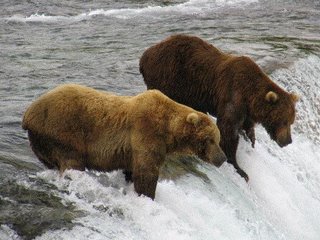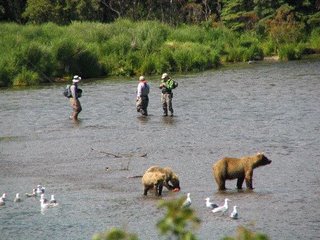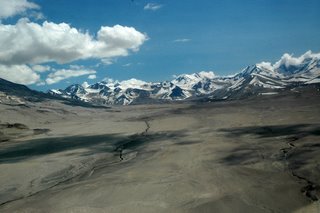20060720 Look Alive
Psychologists define habituation as a decrease in response to a stimulus after repeated presentations. You buy the album for the hit song, and after listening to it over and over you like it less and less. Eventually one of the ‘B’ songs may become your favorite. Here in Katmai the bear biologists talk about habituation in bears.
With the exceptions of sows with cubs and courting couples, bears are usually solitary creatures. The abundant salmon in the Brooks River in July draws them into close proximity with one another. When bears first arrive for the salmon derby, they may not be willing to fish near other bears. With repeated exposures, they habituate to the closeness with a tense truce. Bears also habituate to people and become willing to be close to a creature they innately fear.
When bears first arrive for the salmon derby, they may not be willing to fish near other bears. With repeated exposures, they habituate to the closeness with a tense truce. Bears also habituate to people and become willing to be close to a creature they innately fear.
Likewise, the people habituate to the bears. I remember the first bear sightings back in May and how excited we all were. Yesterday and today, as I sat studying at the kitchen table, bears walked by perhaps ten feet away. I confess I hardly took notice.
I confess I hardly took notice.
I must be careful about that, the not noticing. I have a habit of walking with head down lost in thought. A couple of times this has brought me very close to bears.
Operant conditioning forms an association between a behavior and a consequence. With the bears, if they come into camp the bear techs will haze them with stern voice and sometimes various noisemaking percussion instruments and airhorns. The consequence of ambling through camp is being hazed.
The consequence of my daydreaming while strolling so far has been nearly rubbing elbows with Ursus arctos, an encounter that makes my heart go pitty-pat and an encounter I do not care to repeat. Thus operant conditioning has been working on me. I remind myself that I must look alive as I walk, scanning the woods for bears and remembering to repeat the standard “Hey bear!” to alert bears of my presence.
Bears represent one constant if low probability four-legged threat. There is another. We see wolf tracks regularly on the Valley of Ten Thousand Smokes bus tour. A wolf was seen today at Brooks Falls. Some threats have no legs at all, like the lake thirty paces from my doorstep.
Naknek Lake, full of fine suspended glacially-scoured sediment called flour, suffers from multiple-personality disorder. The glacial flour reflects sunlight giving the lake an inviting unreal milky turquoise look on sunny calm days. That inviting look belies a danger. Being glacially fed, Naknek never gets very warm. In fact, it’s downright frigid. Fall into it from a boat or canoe and you will not last for long.
That inviting look belies a danger. Being glacially fed, Naknek never gets very warm. In fact, it’s downright frigid. Fall into it from a boat or canoe and you will not last for long.
Irritating the lake with a little wind leads to anger management issues that greatly increase the likelihood that you will fall in.
fall in.  That wind seems to come fairly regularly as Pacific Ocean and Bering Sea air masses duke it out, throwing punches through Katamai Pass. Williwaws, as these sudden winds are called, can blow through the pass at 100 miles per hour!
That wind seems to come fairly regularly as Pacific Ocean and Bering Sea air masses duke it out, throwing punches through Katamai Pass. Williwaws, as these sudden winds are called, can blow through the pass at 100 miles per hour!
Still another threat comes not from cold but from hot. Thousands of degrees hot. Just 23 miles from where I live in Brooks Camp lies the now-quiet Valley of Ten Thousand Smokes. Ninety-four years ago the largest volcanic eruption of the 20th century occurred there, terrorizing Kodiak villagers for 60 straight hours and dumping a foot of ash on their doorsteps.
Ninety-four years ago the largest volcanic eruption of the 20th century occurred there, terrorizing Kodiak villagers for 60 straight hours and dumping a foot of ash on their doorsteps.
The valley floor may be still now, but the Aleutian volcanoes that surround it are not. The next big paroxysm is not a matter of if but of when. Could this threat become reality tomorrow?
The next big paroxysm is not a matter of if but of when. Could this threat become reality tomorrow?
You know, I’ve decided that is what I like most about this place—the threats. It’s not just the bears, though that threat is the most immediate. All of the threats together, the bears, the wolves, the cold and the hot give one a sense of uneasiness that never goes away. Every time I step outside I need to assess my surroundings.
Perhaps that failure to completely habituate isn’t such a bad thing. Pilots say, “complacency kills.” I feel truly alive here.
Pilots say, “complacency kills.” I feel truly alive here.
With the exceptions of sows with cubs and courting couples, bears are usually solitary creatures. The abundant salmon in the Brooks River in July draws them into close proximity with one another.
 When bears first arrive for the salmon derby, they may not be willing to fish near other bears. With repeated exposures, they habituate to the closeness with a tense truce. Bears also habituate to people and become willing to be close to a creature they innately fear.
When bears first arrive for the salmon derby, they may not be willing to fish near other bears. With repeated exposures, they habituate to the closeness with a tense truce. Bears also habituate to people and become willing to be close to a creature they innately fear.
Likewise, the people habituate to the bears. I remember the first bear sightings back in May and how excited we all were. Yesterday and today, as I sat studying at the kitchen table, bears walked by perhaps ten feet away.
 I confess I hardly took notice.
I confess I hardly took notice.I must be careful about that, the not noticing. I have a habit of walking with head down lost in thought. A couple of times this has brought me very close to bears.
Operant conditioning forms an association between a behavior and a consequence. With the bears, if they come into camp the bear techs will haze them with stern voice and sometimes various noisemaking percussion instruments and airhorns. The consequence of ambling through camp is being hazed.
The consequence of my daydreaming while strolling so far has been nearly rubbing elbows with Ursus arctos, an encounter that makes my heart go pitty-pat and an encounter I do not care to repeat. Thus operant conditioning has been working on me. I remind myself that I must look alive as I walk, scanning the woods for bears and remembering to repeat the standard “Hey bear!” to alert bears of my presence.
Bears represent one constant if low probability four-legged threat. There is another. We see wolf tracks regularly on the Valley of Ten Thousand Smokes bus tour. A wolf was seen today at Brooks Falls. Some threats have no legs at all, like the lake thirty paces from my doorstep.
Naknek Lake, full of fine suspended glacially-scoured sediment called flour, suffers from multiple-personality disorder. The glacial flour reflects sunlight giving the lake an inviting unreal milky turquoise look on sunny calm days.
 That inviting look belies a danger. Being glacially fed, Naknek never gets very warm. In fact, it’s downright frigid. Fall into it from a boat or canoe and you will not last for long.
That inviting look belies a danger. Being glacially fed, Naknek never gets very warm. In fact, it’s downright frigid. Fall into it from a boat or canoe and you will not last for long.Irritating the lake with a little wind leads to anger management issues that greatly increase the likelihood that you will
 fall in.
fall in.  That wind seems to come fairly regularly as Pacific Ocean and Bering Sea air masses duke it out, throwing punches through Katamai Pass. Williwaws, as these sudden winds are called, can blow through the pass at 100 miles per hour!
That wind seems to come fairly regularly as Pacific Ocean and Bering Sea air masses duke it out, throwing punches through Katamai Pass. Williwaws, as these sudden winds are called, can blow through the pass at 100 miles per hour!Still another threat comes not from cold but from hot. Thousands of degrees hot. Just 23 miles from where I live in Brooks Camp lies the now-quiet Valley of Ten Thousand Smokes.
 Ninety-four years ago the largest volcanic eruption of the 20th century occurred there, terrorizing Kodiak villagers for 60 straight hours and dumping a foot of ash on their doorsteps.
Ninety-four years ago the largest volcanic eruption of the 20th century occurred there, terrorizing Kodiak villagers for 60 straight hours and dumping a foot of ash on their doorsteps.The valley floor may be still now, but the Aleutian volcanoes that surround it are not.
 The next big paroxysm is not a matter of if but of when. Could this threat become reality tomorrow?
The next big paroxysm is not a matter of if but of when. Could this threat become reality tomorrow?You know, I’ve decided that is what I like most about this place—the threats. It’s not just the bears, though that threat is the most immediate. All of the threats together, the bears, the wolves, the cold and the hot give one a sense of uneasiness that never goes away. Every time I step outside I need to assess my surroundings.
Perhaps that failure to completely habituate isn’t such a bad thing.
 Pilots say, “complacency kills.” I feel truly alive here.
Pilots say, “complacency kills.” I feel truly alive here.
.jpg)

0 Comments:
Post a Comment
<< Home